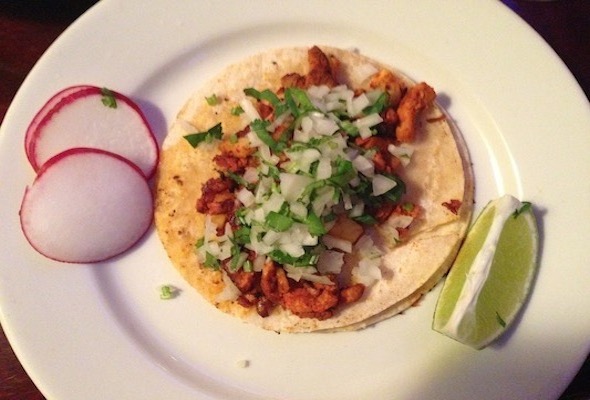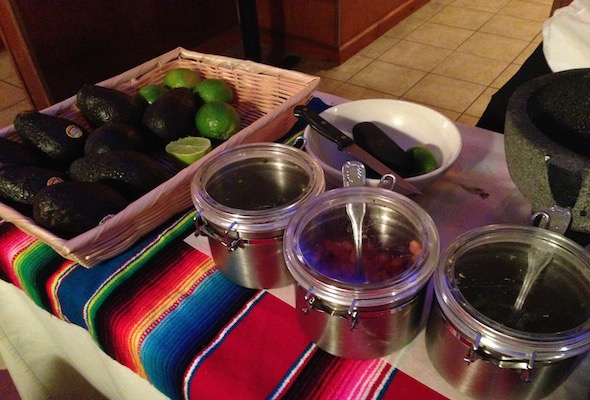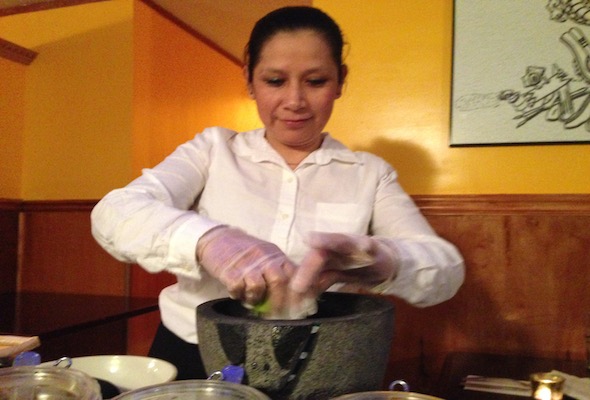A taste of home

Inside Mexico 2000, a month-old restaurant in south Williamsburg, a woman pushes a guacamole cart up to a table and mashes up an avocado in front the customers. She tosses in a spoonful of cumin, squirts some lime juice, and mixes in jalapeño and tomatoes.
“When somebody asks for guacamole, we make it in the moment,” says co-owner Sergio Megiu, a short man with slicked-back hair who wears a suit and a smile. He is protective of the flavor, and if he sees someone add too much sour cream to the restaurant’s dishes, his smile will quickly fade. “We make everything. Even our tortillas are handmade. I’m bringing in food here to impress people, this is not Taco Bell,” he says. “We put a lot of love to get that flavor.”
Most of the recipes traveled here from Puebla, Mexico, an east-central state famous for molé poblano, a chicken dish whose sauce combines the sweetness of chocolate with the tart flavor of tomatillos, and the spiciness of pepper. Sergio and his brother and co-owner, Adrian, were born in Puebla and came to America with their parents in the late ‘90s, walking for miles in the desert to cross the border into the United States. Sergio says that every few miles he saw skeletons poking out of the sand, but beyond that he prefers not to talk about the past. His family settled in New York. “The good thing is that we are all here without problems,” he says.
At age 11, Sergio started going door-to-door in his neighborhood to sell tomatoes, and when he was 18 years old, he and Adrian opened a bodega on Broadway in Williamsburg, at the time a crime-ridden part of Brooklyn.
They sold prepared foods like their $3 roasted pork tacos, sprinkled with cilantro and sautéed pineapple, and soon the hole-in-the wall bodega off the J Train on Marcy Avenue filled with customers. The only two tables tucked in the back could not hold everyone.
“If you don’t know how to pick a good pineapple, you are lost,” says Sergio, now 32. “It has to be a nice one, a hard one, a green one.”

Mexico 2000’s roasted pork tacos, sprinkled with cilantro and sautéed pineapple. These $3 tacos are served at both a sit-down restaurant and a hole-in-the wall bodega off the J Train on Marcy Avenue. Photo: Lisa Spear.
As the bodega’s popularity grew, customers asked the brothers to open a restaurant. “Little by little we were saving every penny, every penny,” Sergio says. They signed a ten-year lease for the space in 2011, but had to delay the opening because of building permit issues. Mexico 2000 finally opened last month.
Since the grand opening, the brothers have juggled about 20 sit-down customers daily, along with an average of 100 deliveries. They expect business to pick up once the winter weather subsides.
They work around the clock to keep the restaurant and the bodega going, sometimes only getting three or four hours of sleep. On holidays the brothers send money to their relatives in Mexico, who are retired farm workers.
Although the plan was always to go back home back to Mexico, success has changed their minds. “When we started it was to make a couple of dollars and go back to Mexico,” says Sergio, who became a citizen four years ago. “We became so popular, there was no space. But the plan was never to open a restaurant. “
The restaurant clientele is a mix of nearby residents in their twenties, who have been known to steal a bottle of Mexico 2000’s homemade green tomatillo sauce, and Latinos who live in the neighborhood and come in with their families.
“It’s an environment for everyone,” says 19-year-old Jennifer Garcia, one of three waitresses. Her parents emigrated from a small town outside of Oaxaca, Mexico, and settled in Williamsburg 15 years ago. Before she was a waitress, she was a regular customer of the bodega.

Waitresses at Mexico 2000 roll a guacamole cart around the restaurant. Photo: Lisa Spear.
“Where else can you get guacamole like this?” asks 23-year-old Colm Dillane, as he sips a michelada, a Mexican beer mixed with hot sauce. He lives above a storefront a few blocks away, where he designs and sells screen-printed t-shirts for his business, “Superkid.” Since moving to Williamsburg two years ago, he has spent several nights a week eating at the bodega, and now at the restaurant.
“Everything is on point,” said Joamy Dominguez, a first-time customer at Mexico 2000 who made the trip to try out the food. As he takes his last bite of his chicken flautas, he says, “We are leaving here stuffed, with a smile on our faces.” Empty bottles of pineapple Jarritos, a popular soda in Mexico, crowd the table.
About 50 percent of the customers are native Spanish-speakers, but in the last 15 years the clientele has shifted, as has the neighborhood. While the Latino population in New York City as a whole continues to climb, the population in Williamsburg is slowly disappearing, with a 33 percent drop in the Mexican population since the brothers opened their bodega, according to the New York City Department of City Planning’s Census FactFinder.
“Rents are killing people,” say Sergio of local apartment prices. “People are paying $2-3,000 and it’s very difficult to pay that amount.”
The brothers pay $8,000 a month to rent the restaurant space. Sergio’s apartment, just a block away from Mexico 2000, is $1,500 per month. He shares the space with his 3-year-old daughter and his wife, who will give birth to their second child in May.
“It’s a little bit difficult,” he says. Fifteen years ago, Sergio paid $600 a month for a large one- bedroom apartment in Williamsburg, and there was no competition. Although the area Mexican population is dropping, today there are more than 14 Mexican restaurants in Williamsburg and four Mexican restaurants within blocks. But Sergio says they are not afraid of the competition.
As long as the customers keep coming, Sergio says, he and his brother will keep expanding; they think about opening a restaurant in Manhattan.

One of Mexico 2000’s three waitresses, Martha Morales, squirts lime juice into the restaurant’s spicy guacamole. Photo: Lisa Spear
“Believe it or not, the United States is the only place for opportunities. Only this country can help you,” says Sergio. “This is like a dream. We can’t believe it. I still don’t know if I am going to wake up.”
Tags: bodega, Brooklyn, Food, immigration, Mexican, molé poblano, NYSD2D, Population Changes, Puebla, Williamsburg
Your Comments